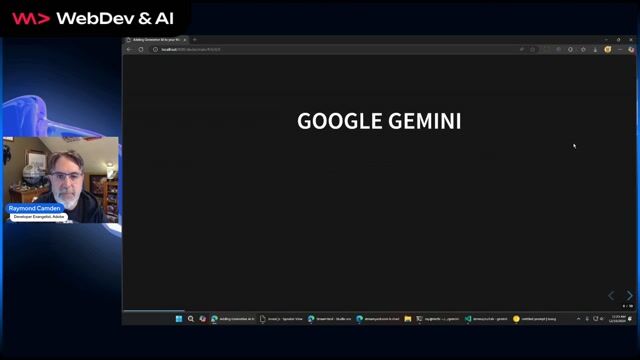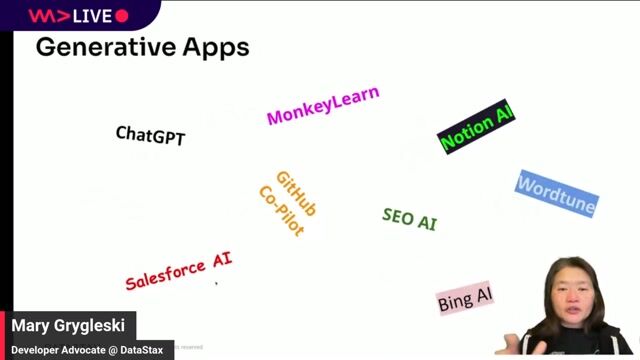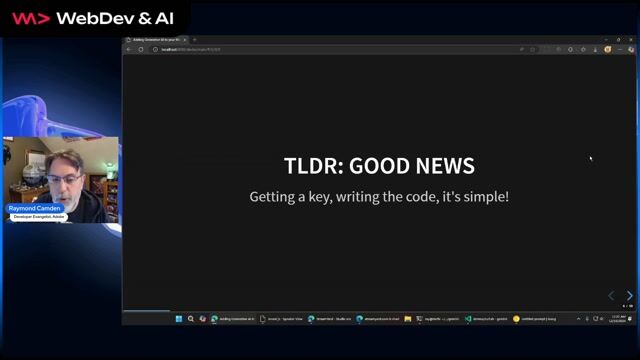Logan Kilpatrick
What’s New with Google Gemini?
#1about 2 minutes
The history and merger of Google's AI teams
Google merged its independent research groups like DeepMind and Google Brain to focus on the horizontal value of large language models like Gemini.
#2about 2 minutes
Overcoming model fatigue for developers
The rapid release of numerous AI models creates overwhelm, which can be solved with product features like personalized benchmarks to help developers choose the right tool.
#3about 5 minutes
Choosing between general and domain-specific models
While domain-specific models have their place, powerful general-purpose models often provide a better balance of world knowledge and capability with less development effort.
#4about 3 minutes
The challenge of moving AI from demo to production
It's easy to create a simple AI demo, but the "last mile" to a reliable production application is difficult due to unpredictable model behavior and a lack of mature infrastructure.
#5about 3 minutes
Managing the economic cost of building with AI
High API costs are a major barrier for developers, which Gemini addresses by optimizing for cost-per-intelligence and offering a generous free tier for experimentation.
#6about 3 minutes
The importance of model-agnostic developer tooling
Developers prefer model-agnostic infrastructure to avoid lock-in, so platforms like Google AI Studio are designed as starting points to get an API key and then build elsewhere.
#7about 5 minutes
Navigating regional availability and data ethics
AI model availability is often limited by regional politics and legal frameworks, while developers must also consider the ethical implications of web scraping for data.
#8about 3 minutes
Unlocking insights with multimodal video analysis
Multimodal models like Gemini 1.5 Pro excel at video understanding, enabling developers to unlock and analyze vast amounts of knowledge previously trapped in video files.
#9about 3 minutes
Integrating AI seamlessly into user experiences
The most effective AI integrations are invisible to the user and work in the background to provide value, rather than being a flashy, explicit feature.
#10about 4 minutes
Using open source Gemma for local AI processing
Google's open source Gemma models allow developers to run AI workloads locally, addressing privacy concerns and practical limitations of uploading large datasets.
#11about 8 minutes
Building interactive agents with the Gemini Live API
The new Live API allows developers to build AI agents that can see and hear user context through screen sharing, enabling more powerful and context-aware interactions.
#12about 6 minutes
Using AI to create guided product experiences
Instead of simple chatbots, AI can act as a virtual coworker that guides users through complex software like Photoshop or an IDE, improving onboarding and usability.
#13about 12 minutes
Getting started with the Gemini API and SDKs
Developers can start building with Gemini for free at ai.dev, using SDKs for popular languages like Python and TypeScript to accelerate learning and build more ambitious projects.
Related jobs
Jobs that call for the skills explored in this talk.
Matching moments

03:37 MIN
Understanding Google Gemini models and capabilities
Exploring Google Gemini and Generative AI

31:13 MIN
Running on-device AI in the browser with Gemini Nano
Exploring Google Gemini and Generative AI

02:50 MIN
Understanding the hackathon's open tech stack and rules
Coffee With Developers Michael Koitz

18:41 MIN
Building agents with Google Gemini and open source tools
Beyond Chatbots: How to build Agentic AI systems

05:49 MIN
Understanding the roles of Gemini and Gemma models
Google Gemma and Open Source AI Models - Clement Farabet

28:12 MIN
Exploring practical use cases and model limitations
Exploring Google Gemini and Generative AI

18:03 MIN
GenAI applications and emerging professional roles
Enter the Brave New World of GenAI with Vector Search

12:47 MIN
A vision for conversational AI in job discovery
Gen AI will replace Job Boards, are you ready?
Featured Partners
Related Videos
 50:12
50:12Google Gemini: Open Source and Deep Thinking Models - Sam Witteveen
Sam Witteveen
 47:25
47:25Google Gemma and Open Source AI Models - Clement Farabet
 38:19
38:19Exploring Google Gemini and Generative AI
 59:16
59:16Developer Productivity Using AI Tools and Services - Ryan J Salva
Ryan J Salva
 42:26
42:26How to Avoid LLM Pitfalls - Mete Atamel and Guillaume Laforge
Meta Atamel & Guillaume Laforge
 34:48
34:48Coffee with Developers - Maria Apazoglou
Maria Apazoglou
 33:51
33:51Exploring the Future of Web AI with Google
Thomas Steiner
 27:12
27:12Beyond the IDE: A new era of agent collaboration
Ryan J. Salva
From learning to earning
Jobs that call for the skills explored in this talk.


Lead Fullstack Engineer AI
Hubert Burda Media
München, Germany
€80-95K
Intermediate
React
Python
Vue.js
Langchain
+1

![Senior Software Engineer [TypeScript] (Prisma Postgres)](https://wearedevelopers.imgix.net/company/283ba9dbbab3649de02b9b49e6284fd9/cover/oKWz2s90Z218LE8pFthP.png?w=400&ar=3.55&fit=crop&crop=entropy&auto=compress,format)
Senior Software Engineer [TypeScript] (Prisma Postgres)
Prisma
Remote
Senior
Node.js
TypeScript
PostgreSQL



AIML -Machine Learning Research, DMLI
Apple
Python
PyTorch
TensorFlow
Machine Learning
Natural Language Processing

